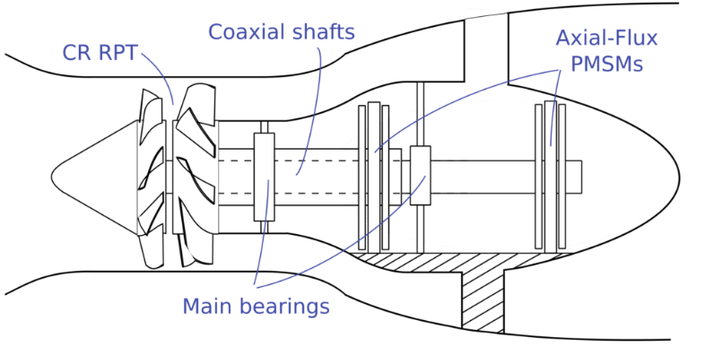Secure, clean and efficient Energy - ALPHEUS
Introduction
Full title: Augmenting grid stability through Low-head Pumped Hydro Energy Utilization & Storage
Duration: 48 months
Number of partners: 11
Coordinator: TU Delft, Department of Mechanical, Maritime, and Materials Engineering
Project description
With a growing share of intermittent renewable energy sources, the grid stability can be maintained, and flexibility enhanced, by applying pumped hydropower energy storage. ALPHEUS will improve reversible pump/turbine (RPT) technology and adjacent civil structures needed to make pumped hydro storage economically viable in shallow seas and coastal environments with a flat topography.
Three promising technologies will be considered:
- Shaft-driven variable-speed contra-rotating propeller RPT – avoiding guide vanes in a two-way device improves overall efficiency
- Rim-driven variable-speed contra-rotating propeller RPT – rim driven configuration avoids the complexity of a shaft assembly, decreasing noise, vibrations, switching time, and maintenance costs
- Positive displacement RPT – fish friendly and seawater-robust, low cost technology
ALPHEUS plans stepwise development, starting by validating current assumptions in the lab and optimizing efficiency with numerical simulations. Based on results, two of these technologies will be chosen and functionality will be demonstrated for working models under realistic circumstances. Finally, a reasoned and quantified assessment of these two technologies will be delivered for further development into full scale prototype. Combining current state-of-the-art and expertise of the partners ALPHEUS expects to reach round-trip RPT efficiency of 0.7 to 0.8. Fatigue resistance of mechanical and civil installations will be addressed, which occur with switching between pumping and turbining modes within 90-120 seconds. ALPHEUS will address environmental aspects, including fish friendliness, scenery and land use, juxtaposed with the ability of decentralized pumped hydro storage to stabilize the grid over a range of timescales and therefore allow higher penetration of intermittent renewable energy supplies. This will result in a methodology for assessing potential sites for pumped low-head and ultra-low head energy storage.
Objectives
These are the objectives of ALPHEUS:
To widen possibilities for incorporating renewable energy sources in the grid/energy system, while maintaining grid stability there is a need for dispatchable renewable energy sources. In particular the aim of ALPHEUS is to develop low head (efficient in a head range spanning from 1-2m on the low side to 10-20m on the high side) seawater compatible pumped storage technologies and methodology for assessing sites around Europe for application of these technologies. Implementations will be designed and developed to meet discrepancy between supply and demand on time scales from minutes to days. The technologies will consist of modular parts allowing for scalability between 300 kW and 10 MW1. The modularity enables adapting the technology to local and regional demand and supply characteristics.
Grid balancing, low-head, seawater hydro power conversion and storage are in the project’s focus. ALPHEUS will develop technologies that make sustainable energies more flexible for the needs of grid operation through storage and provide additional assistance for system stability. Concrete objectives are:
- To design and build model-scale, and establish design parameters for full-scale, hydropower and -storage systems that are suitable for integration into yet unexplored low head sites (down to 1-2m); that can switch from pumping to turbining within 1 minute providing flexibility to the grid; operates at a round trip efficiency of >70% while minimising the environmental impact.
- To design full-scale and build model-scale RPT’s, optimised using a three-dimensional (3D) inverse design methodology amongst other methods (WP2). Optimization criteria are round trip efficiency, mode switching time, and fish mortality.
- To design and build a direct drive Power Take-Off (PTO) system (WP3) with high efficiency over a wide range of operating conditions (>90% down to 20% of the nominal torque and speed).
- To validate the operational efficiency of an integrated model-scale machine set at realistic head conditions in the laboratory (WP4).
- To develop a site assessment methodology for decentralized energy storage, in view of topographical opportunities and constraints, and to develop design considerations and testing protocols for civil structures and related devices addressing fatigue, chemical cycling (seawater), retrofitting, and topographic and ambient conditions (WP5).
- To develop a methodology for the grid level controller for improving the grid stability (WP6).
Role of Ghent University
The activities of UGent in this project are related to the PTO. More specifically, an advanced high-efficient axial flux permanent magnet synchronous generator will be developed and a scale-model will be constructed for lab testing. A full multi-dimensional model-based predictive control system for the machine-side will be developed which is capable of controlling the turbine and PTO to track the power reference as desired by the grid-side control.
Website
Contact
Prof. Jeroen De Kooning
Department of Electromechanical, Systems & Metal Engineering
Phone number: +32 5 624 12 15
E-mail
